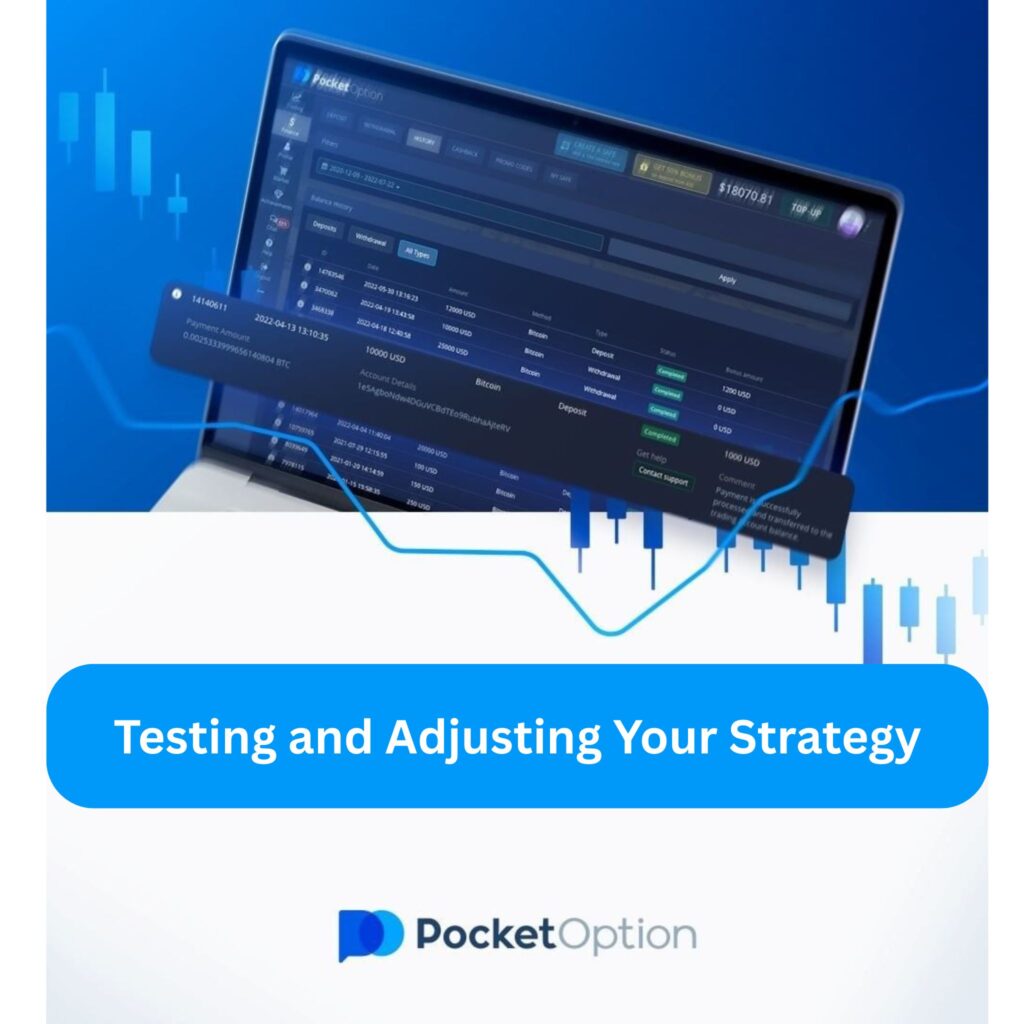Best Strategy on Pocket Option
Choosing the best Pocket Option strategy depends on your trading style, risk tolerance, and market conditions. Whether you prefer trend following, scalping, or swing trading, understanding the available strategies will help you maximize your potential profits and minimize risks. In this guide, we’ll explore the top strategies and how to implement them effectively for success.
Introduction to Pocket Option Trading Strategies
Pocket Option is a leading trading platform that offers a variety of features to help both beginner and experienced traders succeed in the financial markets. Whether you’re trading cryptocurrencies, forex, stocks, or commodities, choosing the right trading strategy is crucial for achieving success and maximizing profits.
Key Factors in Choosing the Best Strategy Pocket Option
Selecting best strategy Pocket Option requires considering several key factors to align your trading approach with your goals and preferences. Here are the main elements to keep in mind:
Your risk tolerance is crucial when choosing a strategy. If you are comfortable with higher risks, you may opt for more aggressive strategies like scalping or news-based trading. However, if you prefer a more conservative approach, trend-following or swing trading may be more suitable. Your trading goals — whether aiming for quick profits or steady long-term gains — will also influence your strategy choice.
Different strategies require different levels of time and attention. If you’re looking for quick, short-term profits, scalping may be ideal, as it involves frequent trades over short periods. For those with more time to dedicate, swing trading or trend following might be more suitable, as they require analyzing longer market trends and holding positions for extended periods.
The market conditions can significantly impact the effectiveness of certain strategies. In volatile markets, strategies like scalping or day trading may work better due to rapid price movements. Conversely, in stable markets, swing trading or trend-following strategies may be more successful. Additionally, the type of asset you’re trading — whether it’s cryptocurrencies, stocks, or forex — can also influence which strategy is most appropriate.
By evaluating these factors, you can choose a strategy that aligns with your personal preferences and the current market conditions, helping you make more informed and effective trading decisions.
Content Overview on Pocket Option Best Strategy
- Introduction to Pocket Option Trading Strategies
- Key Factors in Choosing the Best Strategy Pocket Option
- How to Implement the Best Strategy on Pocket Option
- Top Strategies for Pocket Option
- Risk Management in Trading Strategies Pocket Option
- Testing and Adjusting Your Strategy Pocket Option
- Pocket Option Winning Strategy
- Frequently Asked Questions – Best Strategy on Pocket Option
How to Implement the Best Strategy on Pocket Option
Implementing the best strategy for Pocket Option requires careful planning, the right tools, and consistent execution.
Here’s a step-by-step guide on how to put your chosen strategy into action:
- Set Up Your Trading Tools and Indicators: Depending on your strategy, you’ll need to configure the necessary technical indicators, such as moving averages, RSI, MACD, or Bollinger Bands.
- Analyze the Market: Before entering any trades, conduct a thorough market analysis. Study price charts, market news, and economic events that could affect the assets you plan to trade. If you’re using a news-based strategy, stay updated on financial reports and global events that may impact the market.
- Define Entry and Exit Points: For a successful strategy, it’s crucial to establish clear entry and exit points based on your chosen approach. For example, if you’re using a scalping strategy, you’ll need to determine precise entry points where price fluctuations can yield quick profits.
- Set Risk Management Controls: No strategy is complete without risk management. Set stop-loss and take-profit levels for every trade, ensuring you don’t risk more than you can afford to lose. You can also define how much of your capital you’re willing to risk per trade.
- Start with a Demo Account: Before trading with real money, try your strategy on a demo account. This will allow you to familiarize yourself with the platform and evaluate the effectiveness of the strategy in actual market scenarios.
- Monitor and Adjust Your Strategy: Once you start trading live, monitor your strategy’s performance closely. Market conditions can shift rapidly, so it’s important to be ready to modify your strategy if things aren’t progressing as expected.Regularly review your trades and fine-tune your strategy to improve your results.

Top Strategies for Pocket Option
Selecting the Pocket Option best strategy is essential for achieving success on the platform. By understanding which strategy suits your trading style, goals, and market conditions, you can improve your chances of making profitable trades and maximizing your potential returns. Here are some of the most popular strategies that traders use to maximize their profits:
Trend Following Strategy
The trend following strategy involves identifying and capitalizing on existing market trends. Traders who use this approach believe that assets that have been trending in one direction will continue to do so for a while. By identifying an uptrend or downtrend, traders can enter positions that align with the trend, aiming to profit as the trend continues. It’s a strategy suitable for traders who want to take advantage of longer-term market movements.
Scalping Trading Strategy
Scalping is a fast-paced trading approach that involves executing multiple trades for small profits over a short period. Traders utilizing this method aim to benefit from small price movements, entering and exiting the market in a matter of seconds or minutes. It demands constant attention, quick decision-making, and an active trading style, making it ideal for traders who want to seize minor fluctuations in price throughout the day.
Swing Trading Strategy
Swing trading is a medium-term strategy that involves holding positions for a few days or even weeks to capitalize on price “swings.” Traders using this strategy aim to profit from short- to medium-term price movements, entering the market when a potential price reversal is detected and exiting when the asset reaches the peak of its swing. It’s ideal for traders who can’t monitor the markets constantly but want to capture larger moves within trends.
News-Based Strategy
The news-driven strategy focuses on trading around major economic reports, corporate earnings, or geopolitical events. These events often trigger sharp price movements, offering traders the chance to profit by responding quickly to breaking news. Traders utilize this strategy to predict how such news will influence asset prices in both the short and long term. Success with this strategy requires staying up-to-date with news and interpreting its possible effects on market behavior.
Each of these strategies has its own strengths and weaknesses. By understanding how they work and adapting them to your trading style, you can maximize your chances of success on Pocket Option.
Risk Management in Trading Strategies Pocket Option
Effective risk management is a crucial element for success in trading. It helps protect your capital, reduces potential losses, and ensures that you can trade with confidence. The table below outlines the key aspects of risk management that every trader should incorporate into their strategy for better control and consistent results.
| Risk Management Aspect | Description |
| Capital Protection | Protecting your capital by ensuring that you only risk a small percentage of your total funds per trade. |
| Risk-Per-Trade Limits | Limiting the amount of capital you risk on each trade (typically 1-2% of your account balance). |
| Emotional Control During Trading | Maintaining emotional discipline by sticking to your predefined strategy and avoiding impulsive decisions during live sessions. |
Testing and Adjusting Your Strategy Pocket Option
To ensure your trading strategy is effective, it’s important to test and adjust it regularly. Here are key steps to help you refine your approach:
- Backtest your strategy using historical data to evaluate past performance.
- Start with a demo account to test in real market conditions without risk.
- Evaluate performance by reviewing your trades, profits, and losses.
- Adjust your strategy as needed based on the market conditions and performance metrics.
- Track key performance metrics like win rate and risk-to-reward ratio to measure success.
By consistently testing and adjusting your strategy, you can enhance your trading results and adapt to changing market dynamics.

Pocket Option Winning Strategy
Frequently Asked Questions – Best Strategy on Pocket Option
What is the best strategy for beginners on Pocket Option?
For beginners, a trend-following strategy is highly recommended. It involves identifying the current market trend and trading in the direction of that trend. This approach is simple and can help new traders gain confidence without relying on complex analysis.
How can I improve my chances of success with Pocket Option?
To increase your chances of success, focus on mastering risk management and selecting a strategy that suits your trading style. Consistently test your strategy, monitor market conditions, and avoid emotional trading to stay on track with your long-term goals.
Can I combine different strategies on Pocket Option?
Yes, many successful traders combine multiple strategies depending on market conditions. For instance, you might use trend following during strong market trends and switch to scalping during high volatility for short-term gains. Just ensure you stay disciplined and consistent.
How do I manage risk while using a strategy on Pocket Option?
To manage risk effectively, always set stop-loss and take-profit levels before entering a trade. Limit the amount of capital you risk on each trade (1-2% of your total account balance), and never let emotions drive your decisions. Use demo accounts to practice risk management before going live.
